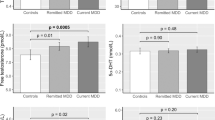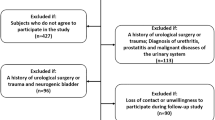Abstract
Androgen insufficiency is a recognized cause of sexual dysfunction in men and women. Age-related decrements in adrenal and gonadal androgen levels also occur naturally in both sexes. At present, it is unclear if a woman's low serum androgen level is a reflection of the expected normal age-related decline or indicative of an underlying androgen-deficient state. We studied premenopausal women with no complaints of sexual dysfunction to help define a normal female androgen profile. In all, 60 healthy, normally menstruating women, ages 20–49 y, were studied. The Abbreviated Sexual Function Questionnaire was administered along with a detailed interview. Radioimmunoassay measurements of morning serum testosterone (T), free testosterone (fT), dehydroepiandrosterone-sulfate (DHEAS), sex hormone-binding globulin (SHBG), and free androgen index (FAI) were measured during days 8–15 of the menstrual cycle. In women 20–49 y old without complaints of sexual dysfunction, serum androgen levels exhibit a progressive stepwise decline. Comparing values obtained in women age 20–29 y to those obtained in women 40–49 y, specific hormone decrements were DHEAS 195.6–140.4 μg/dl, serum T 51.5–33.7 ng/dl, fT 1.51–1.03 pg/ml. SHBG did not change significantly in women in this age group. The FAI reflected the age-related decrease in female androgen levels. The framework for the development of a female androgen profile in women with no complaints of sexual dysfunction has been established, and an age-related decrease in testosterone and its adrenal precursor, DHEAS, has been demonstrated. The FAI mirrors these decreases and its usefulness in clinical practice is confirmed. A precipitous decline in all androgens occurs after the decade of the 20s, yet SHBG does not show a significant change throughout the premenopausal years.
This is a preview of subscription content, access via your institution
Access options
Subscribe to this journal
Receive 8 print issues and online access
$259.00 per year
only $32.38 per issue
Buy this article
- Purchase on Springer Link
- Instant access to full article PDF
Prices may be subject to local taxes which are calculated during checkout




Similar content being viewed by others
References
Bachmann G et al. Female androgen insufficiency: the Princeton consensus statement on definition, classification, and assessment. Fertil Steril 2002; 77: 660–665.
Labrie F et al. Marked decline in serum concentrations of adrenal C19 sex steroid precursors and conjugated androgen metabolites during aging. J Clin Endocrinol Metab 1997; 82: 2396–2402.
Maccario M et al. Relationships between dehydroepiandrosterone-sulfate and anthropometric, metabolic and hormonal variables in a large cohort of obese women. Clin Endocrinol 1999; 50: 595–600.
Sulcova J, Hill M, Hampl, Starka L . Age and sex related differences in serum levels of unconjugated dehydroepiandrosterone and its sulfate in normal subjects. J Endocrinol 1997; 154: 57–62.
Orentreich N, Brind JL, Rizer RL, Vogelman JH . Age changes and sex differences in serum dehydroepiandrosterone sulfate concentrations throughout adulthood. J Clin Endocrinol Metab 1984; 59: 551–555.
Lasley BL et al. The relationship of circulating dehydroepiandrosterone, testosterone, and estradiol to stages of the menopausal transition and ethnicity. J Clin Endocrinol Metab 2002; 87: 3760–3767.
Zumoff B, Strain GW, Miller LK, Rosner W . Twenty-four-hour mean plasma testosterone concentration declines with age in normal premenopausal women. J Clin Endocrinol Metab 1995; 80: 1429–1430.
Laumann EO, Paik A, Rosen RC . Sexual dysfunction in the United States: prevalence and predictors. J Am Med Assoc 1999; 281: 537–544.
Vermeulen A . The hormonal activity of the postmenopausal ovary. J Clin Endocrinol Metab 1976; 42: 247–253.
Vierhapper H, Nowotny P, Waldhausl W . Determination of testosterone production rates in men and women using stable isotope/dilution and mass spectrometry. J Clin Endocrinol Metab 1997; 82: 1492–1496.
Massafra C et al. Androgens and osteocalcin during the menstrual cycle. J Clin Endocrinol Metab 1999; 84: 971–974.
Miller KK et al. Androgen deficiency in women with hypopituitarism. J Clin Endocrinol Metab 2001; 86: 561–567.
Guay AT . Screening for androgen deficiency in women: methodological and interpretive issues. Fertil Steril 2002; 77: S83–S88.
Quirk FH et al. Development of a sexual function questionnaire for clinical trials of female sexual dysfunction. J Women Health Gender-Based Med 2002; 11: 277–289.
Vermeulen A, Verdonck L, Kaufman JM . A critical evaluation of simple methods for the estimation of free testosterone in serum. J Clin Endocrinol Metab 1999; 84: 3666–3672.
Wilke TJ, Utley DJ . Total testosterone, free-androgen index, calculated free testosterone, and free testosterone by analog RIA compared in hirsuite women and in otherwise-normal women with altered binding of sex-hormone-binding globulin. Clin Chem 1987; 33: 1372–1375.
Winters SJ, Kelley DE, Goodpasteur B . The analog free testosterone assay: are the results in men clinically useful? Clin Chem 1998; 44: 2178–2182.
Gershagen S, Doeberl A, Jeppson S, Rannevik G . Decreasing serum levels of sex hormone-binding globulin around the menopause and temporary relation to changing levels of ovarian steroids, as demonstrated in a longitudinal study. Fertil Steril 1989; 51: 616–621.
Burger HG . A prospective longitudinal study of serum testosterone, dehydroepiandrosterone sulfate, and sex hormone-binding globulin levels through the menopause transition. J Clin Endocrinol Metab 2000; 85: 2832–2838.
Rannevik G . A longitudinal study of the perimenopausal transition; altered profiles of steroid and pituitary hormones, SHBG and bone mineral density. Maturitas 1995; 21: 103–113.
Bancroft J, Cawood EH . Androgens and the menopause; a study of 40–60 year-women. Clin Endocrinol (Oxf) 1996; 45: 577–587.
Author information
Authors and Affiliations
Corresponding author
Additional information
This research was supported by a private grant from the Ellithorpe family.
Appendices
Appendix A. Abbreviated Sexual Function Questionnaire (ASFQ)
Appendix B
Criterion for determining normal sexual function can be summarized in Table B1 for the 15-item version of the SFQ
Rights and permissions
About this article
Cite this article
Guay, A., Munarriz, R., Jacobson, J. et al. Serum androgen levels in healthy premenopausal women with and without sexual dysfunction: Part A. Serum androgen levels in women aged 20–49 years with no complaints of sexual dysfunction. Int J Impot Res 16, 112–120 (2004). https://doi.org/10.1038/sj.ijir.3901178
Received:
Revised:
Accepted:
Published:
Issue Date:
DOI: https://doi.org/10.1038/sj.ijir.3901178
Keywords
This article is cited by
-
Do oral combined contraceptive pills modify body image and sexual function?
Reproductive Biology and Endocrinology (2022)
-
The clinical management of testosterone replacement therapy in postmenopausal women with hypoactive sexual desire disorder: a review
International Journal of Impotence Research (2022)
-
Vitamin E as alternative local treatment in genitourinary syndrome of menopause: a randomized controlled trial
International Urogynecology Journal (2019)
-
StuI polymorphism on the androgen receptor gene is associated with recurrent spontaneous abortion
Journal of Assisted Reproduction and Genetics (2013)
-
‘Off-label’ drug use in sexual medicine treatment
International Journal of Impotence Research (2008)



